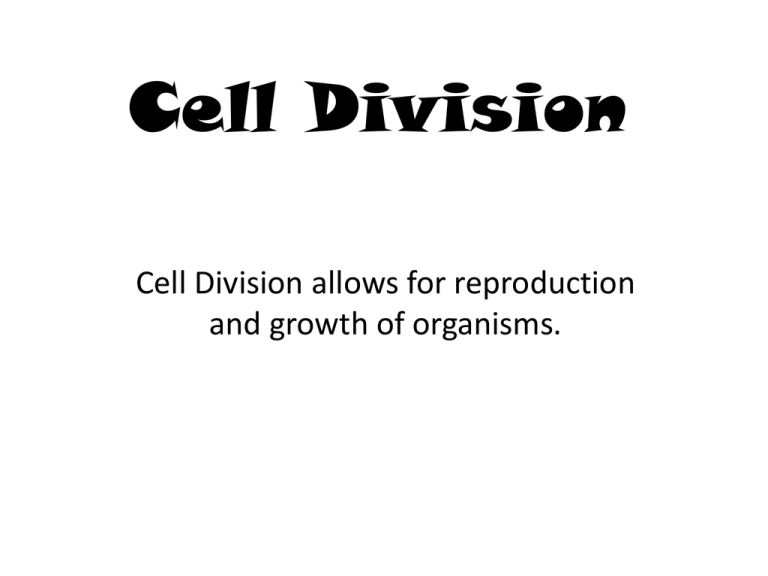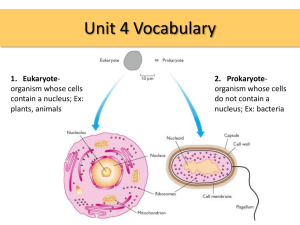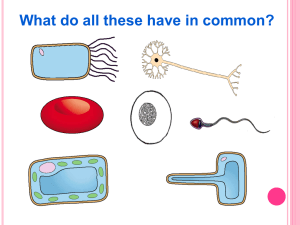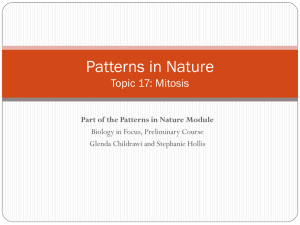
Cell Division
Cell Division allows for reproduction
and growth of organisms.
Learning Outcomes
• state that mitosis occupies only a small
percentage of the cell cycle and that the
remaining percentage includes the copying
and checking of genetic information
Chromosomes
• Are found in the nucleus of eukaryotic cells
• Are made up of DNA and histone proteins
• Hold instructions for making new cells
– Specific lengths of DNA are called genes
• The number of chromosomes in each cell is
characteristic of each species
– There are 46 chromosomes in humans
• Daughter cells must contain a full set of
chromosomes
– Before a cell divides the DNA of each chromosome must
be replicated
Structure of a chromosomes
Chromatid
A replica strand of DNA
Each one will end up in a
different daughter cell
Centromere
Holds the two copies
together.
Chromatin is supercoiled to form visible
chromosomes, this allows them to be moved around..
The Cell Cycle
describes the events that take place as one parent cell divides to produce new
daughter cells which then each grow to full size.
• M
– Nuclear division (mitosis)
– Cytokinesis (cleavage of cytoplasm)
• Interphase
– G1
• Biosynthesis – proteins are made and organelles replicate,
–S
• Synthesis of new DNA
• Replication of chromosomes
– G2 - growth
The Cell Cycle (recap)
• The cell cycle has 3 main phases
– Interphase
• cell grows to normal size
• carries out normal biochemical functions
• DNA replication takes place
– Nuclear division
• mitosis, this has 4 stages;
– prophase, metaphase, anaphase and telophase
– Cell division
• cytoplasm divides by cytokinesis
The Cell Cycle
Learning Outcomes
• Recap
– state that mitosis occupies only a small percentage of the
cell cycle and that the remaining percentage includes the
copying and checking of genetic information
• explain the meaning of the term homologous pair of
chromosomes;
• describe, with the aid of diagrams and photographs,
the main stages of mitosis (behaviour of the
chromosomes, nuclear envelope, cell membrane and
centrioles);
Nuclear Division
• looking at the Karyotype of a human male,
you can see:
– Homologous pairs – each pair has distinctive
banding when stained.
– 22 pairs of autosomes
– 1 pair of sex chromosomes (female XX; male XY)
Karyotype
• Human body cells are diploid (2n), meaning
that they have 2 sets of chromosomes.
Human gametes are haploid (n), where n is
the number of chromosomes in a single set
Learning Outcomes
• describe, with the aid of diagrams and
photographs, the main stages of mitosis
(behaviour of the chromosomes, nuclear
envelope, cell membrane and centrioles);
Mitosis
• Nucleus of a cell divides resulting in two nuclei
which are genetically identical to the parent
nucleus.
• 4 stages
– Prophase
– Metaphase
– Anaphase
– Telophase
Prophase
Chromosomes become visible and the nuclear envelope disappears
Metaphase
Chromosomes arrange themselves at the centre (equator) of the cell.
Anaphase
Chromatids migrate to opposite poles
Telophase
The nuclear envelope reforms
Learning Outcomes
• explain the significance of mitosis for growth,
repair and asexual reproduction in plants and
animals;
• state that cells produced as a result of meiosis
are not genetically identical (details of meiosis
are not required);
Requirements of Nuclear Division
• There are two requirements of nuclear
division
– Growth (Mitosis);
• where a diploid zygote grows into a multi-cellular adult,
all daughter cells have the same number of
chromosomes as the parent cell.
– sexual reproduction (Meiosis);
• the number of chromosomes is halved so that gametes
are haploid
Human Life Cycle
Diploid
Zygote
46
fertilisation
Haploid
Sperm
23
Haploid
Egg
23
Adult
46
Meiosis
• Chromosome number is halved so human
gametes have 23 chromosomes
• This reduction in chromosome number
ensures that when gametes fuse to form a
zygote (fertilisation) the diploid chromosome
number is restored.
Meiosis
Learning Outcomes
• outline, with the aid of diagrams and
photographs, the process of cell division by
budding in yeast;
Cell Division
• In most cells, the nucleus divides first then the
cytoplasm (cytokinesis).
• This is mitosis and can be used for:
– Growth and repair
– Replacement of cells
– Asexual reproduction
• In bacteria, cell division takes place by binary fission
– DNA replicates
– Cell divides
Cell division in yeast
• Yeast is a single celled fungus
• It reproduces asexually by budding
– Cell produces a swelling (bud)
– Nucleus divides into two – the bud gains a nucleus
– The bud breaks off leaving a bud scar
• Sometimes buds produce their own buds
before separating.
Learning outcomes
• To define the term stem cell
• Explain the meaning of the terms tissue, organ and
organ system;
• explain, with the aid of diagrams and photographs,
how cells are organised into tissues, using as
examples
– squamous and ciliated epithelia,
– xylem and phloem
• discuss the importance of cooperation between cells,
tissues, organs and organ systems
Stem Cell
• Stem cells are omnipotent or totipotent
• The are cells which contain a full set of genetic
information, and are capable of becoming any
one of the different cell types found in a fully
grown organism.
Stem Cells
• There are a small number of stem cells found
in adult mammals in the bone marrow, these
are responsible for the formation of bone cells
and blood cells.
• Stem cells are currently being used in medical
research.
Differentiation
• Unspecialised cells which show totipotency
include
– Stem cells in animals
– Meristematic cells in plants
• These cells divide and then specialise, this is
differentiation.
Differentiation and organisation
• There is a physical limit to the size a single cell
can reach, therefore multicellular organisms
need specialised cells.
• These specialised cells are organised into
tissues which carry out a specific function.
• Tissues are organised into organs.
Differentiation of cells
• Cells differentiate in a number of ways, by changing:
– The number of a particular organelle
• Muscle and liver cells contain many mitochondria
– The shape of the cell
• Red blood cells are a biconcave shape
– Some of the cell contents
• Red blood cells do not contain a nucleus
• Differentiation means to specialise to carry out a
particular role or function.
Examples of specialised cells
Erythrocytes
Neutrophils
Sperm
Root hair cells
Structure of specialised cells
Try to write out the specific function of each specialisation
Lose their nucleus,
mitochondria, Golgi
apparatus and RER
Contain Haemoglobin
Granular cytoplasm
due to large numbers
of lysosomes
Erythrocytes
Neutrophils
Energy for movement of the
undulipodium comes from the
large number of mitochondria.
Head contains specialised
lysosomes
Hair-like extension, to
increase the surface area
for water absorption.
Sperm
Root hair cells
Tissues, organs and systems
• Tissue
– a group of similar specialised cells in a many celled
organism, that carries out a specific function or several
related functions
• Organ
– group of different tissues forming a distinct structure and
functioning together
• animal – lungs, heart, kidneys
• plant – roots, stems, leaves
• System
– collection of organs with a particular function
• cardiovascular and digestive systems
Tissues
• A tissue is a group of similar, specialised cells
which carry out a specific function, or several
related functions.
– Animal tissues
• squamous and ciliated epithelium
– Plant tissues
• Xylem and phloem
Animal Tissues
• Tissues that form sheets covering surfaces are
called epithelial tissues, epithelial tissues are
one cell thick and rest on a basement
membrane (a network of collagen and
glycoproteins), which holds the cells in
position.
• Two examples of animal tissues are squamous
and ciliated epithelium.
Ciliated Epithelium
• This tissue is found
lining the ends of
the bronchioles in
the lungs.
Squamous Epithelium
• This tissue covers many surfaces in the human
body including the inner lining of cheeks and
lining the walls of the alveoli in the lungs.
• In the alveoli, the thinness of cells allows rapid
diffusion of gases between alveoli and blood.
Squamous Epithelium
Plant Tissues
• Examples of plant tissues include xylem
and phloem, which are transport tissues
in plants.
– Xylem transports water and ions, phloem
transports sugars and other compounds
made by plants.
• Tissues can be presented in plan
diagrams, plan diagrams DO NOT show
any individual cells.
Plan Diagrams – dicotyledonous
leaf
Plan Diagrams - dicotyledonous leaf










